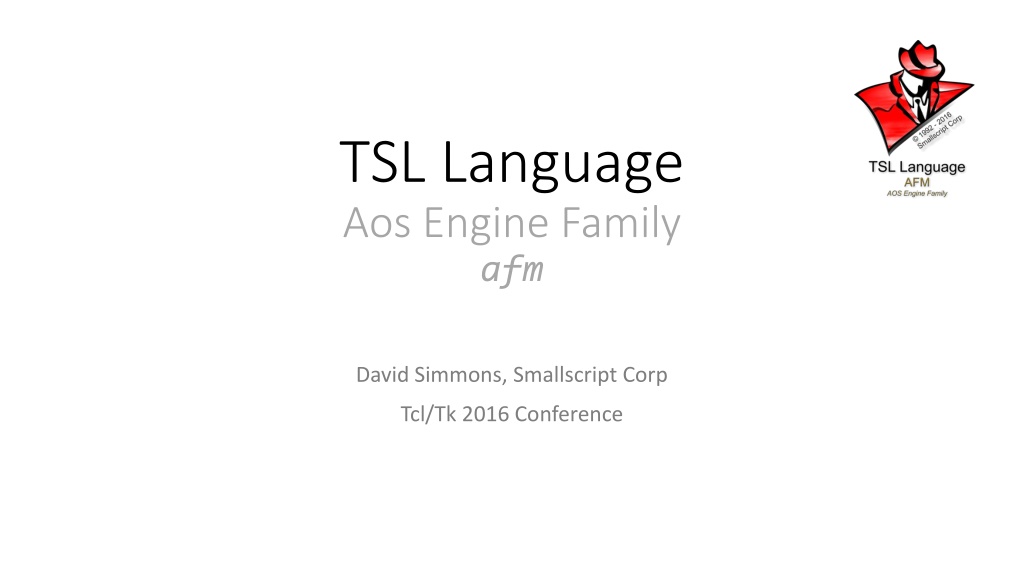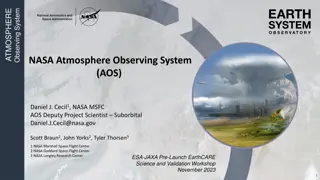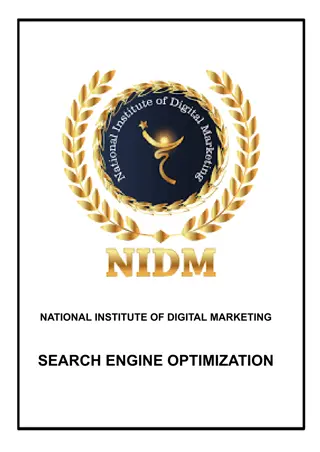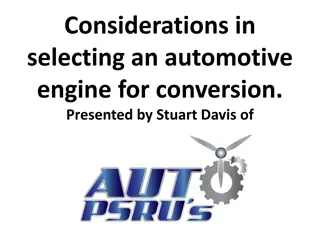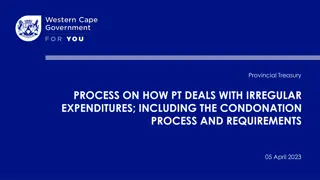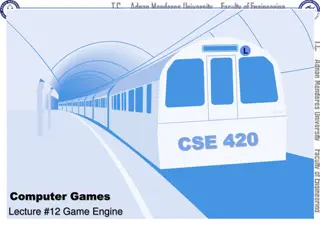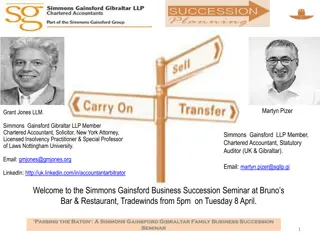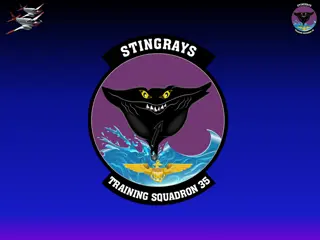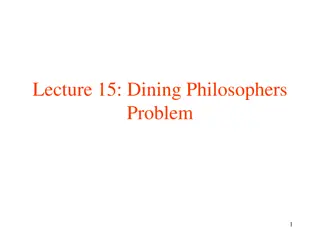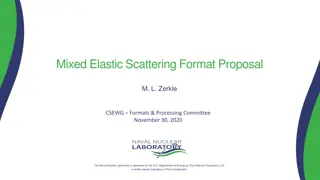Introduction to TSL Language and AOS Engine Family by David Simmons
David Simmons presents an overview of TSL Language and AOS Engine Family, focusing on their applications and his extensive experience in software engineering and architecture. The presentation covers the development history, key language systems, and the principles underlying TSL as a Domain Specific Language with a foundation in TCL. Various aspects such as macro patterns, object integration, and execution models are discussed, showcasing the versatility and capabilities of TSL in high-performance runtime systems.
Download Presentation

Please find below an Image/Link to download the presentation.
The content on the website is provided AS IS for your information and personal use only. It may not be sold, licensed, or shared on other websites without obtaining consent from the author. Download presentation by click this link. If you encounter any issues during the download, it is possible that the publisher has removed the file from their server.
E N D
Presentation Transcript
TSL Language Aos Engine Family afm David Simmons, Smallscript Corp Tcl/Tk 2016 Conference
What we are going to briefly tour this afternoon.. TSL Text Scripting Language AFM Its COFF binary executable host Aos Engine Family 11/17/2016 TSL Talk by David Simmons, Smallscript Corp (c) 2016 2
Brief Intro, then on to demos and tour Hello, my name is David Simmons For 25 years I ve had a particular specialization in high-performance hybrid dynamic-static language runtime systems. By education, I am an Electrical Engineer and Astrophysist specialized in VLSI design. However, most of my career has been as a Software Engineer and Architect Working on Operating Systems, Hardware Devices, Real Time Systems and Programming Languages and their Execution Machinery and Infrastructure I began my career some 40 years ago, in the summer of 1976 at The National Bureau of Standards which is known today as NIST (The National Institute of Science and Technology) working on Fortran Runtime Real Time Libraries, Perkin Elmer Operating System Development, and ArpaNet NBS Net Packet Switch Hardware and Analyzers. Employed working with or for: NBS/NIST, U.S. Congress, Air Force, Faculty at UofMd NSF Systems Research Center, Tokyo Gas, Apple, Suse Linux, Microsoft and worked for or owned a number of small to mid-size companies of up to 250 employees. Worked on, collaborated on or was lead architect on the following language systems: Apple s Kaleida, Apple s AppleScript, Apple s Quicktime-Track-Scripting, Script on Newtons Basic, Forth, Message-C, SIAL (1990 ODBC equivalent with full-text search engine), Smalltalk and Prolog, S# Microsoft Visual Basic, Javascript/JScript, .NET Runtime (desktop, mobile), XNA, Powershell 11/17/2016 TSL Talk by David Simmons, Smallscript Corp (c) 2016 3
DEMO afts Command Line Script 11/17/2016 TSL Talk by David Simmons, Smallscript Corp (c) 2016 4
DSL: Domain Specific Language TSL As a language TSL is founded on the macro and command patterns used in TCL As C++ can be described in relation to C, TSL can be described in relation to TCL Smalltalk, Lisp, Self messaging behavior and TCL JavaScript blended syntax & intrinsic JSON Intrinsic C++ object integration Macro & Command Patterns Frameworks, IDE, Image-Snapshots, Intrinsic-Repos Executable Libraries: Source, Op-Codes, and precompiled Machine Code Object Model: prototype, mixins Host Integration & LifecycleModel Path Binding Engine: predicate binder Execution Invocation: Interp-JIT, FFI Dynamic Composition Aspect-weaving and introspection Perspective Types: Versioning, Modularization, Security AOS Execution Engine and Container System 11/17/2016 TSL Talk by David Simmons, Smallscript Corp (c) 2016 5
AFM executable Self-installing single host executable that uses symbolic-link file-naming to determine its execution behavior The executable s File Name is used by afconfig code to determine the execution path as it examines the exec command line; this allows efficient creation of single shared binary tools using symbolic-link naming patterns. Fossil-SCM aflib afconfig.tsl .afr Repo db(s) Files and Directories BuiltIn FileSystem TSL Language C/C++ implementation SqLite AOS Execution Engine System and Libraries Intrinsic Resources C/C++ Libraries and Services afts afm COFF (binary bundled) Executable Intel, ARM, *nix, ms-windows 11/17/2016 TSL Talk by David Simmons, Smallscript Corp (c) 2016 6
Startup sequence Script binding: shebang #! /local/bin/afts ms-pathext ftype.exe && assoc.exe registry mapping Engine Init TSL Core Registered main Process Exec primary thread Link-name executed as command, if available Not-found Hook Invoked to load command afconfig.tsl config located and run 1. 2. 3. 4. current directory ~/ user s home directory ee s home directory coff-builtin directory Command Executed as Program afm Fall-through to fossil-default OR 11/17/2016 TSL Talk by David Simmons, Smallscript Corp (c) 2016 7
Language Statements, Expressions and other Concepts TCL Statement Composed of Words First Word is Command Rest is Command Macro Params Expressions Things Scalars Key-Value Containers TSL Statement Composed of First Word and Rest First Word is Message Command, Function or Method Rest is Message DSL Params Literal, Macro, Eval Things Scalars Mixin Prototype Dynamic Objects 11/17/2016 TSL Talk by David Simmons, Smallscript Corp (c) 2016 8
Operators and Keywords Syntax, Semantics and DSL patterns Operator { } " " ' ' ` ` [ ] ( ) -- $ & -- \ ; , -- # /* */ // Language Type tcl tcl+ tcl tsl Patterns text patterns. prefix-names. $( ), $[ ], ${ } forms. ( ) invocation. Quirks for "[ ]". proc, func, method patterns. Unary and binary symbolmethod patterns. implicit eval pattern. Literal Macro Command Expr(eval) tcl+ tsl MX path Operator RefpathOperator macro-expand operator for variables and other tokens. reference operator for variables and path expressions. tcl+ tcl tsl Escape Operator End-of-statement End-of-expression enables UTF8, ascii and inline-operator escapes. TCL quirks mode for newline and curly-brace EOS. Expr eval param delimiter. tcl+ Comments JavaScript/C++ compatible comments. Quirks for TCL #. Keywords super this tsl Description inheritance operator and contextual variable for accessing inheritance and behavior properties. Within command declaration: this, , args, *, &, ^. identifier character whose usage rules are restricted to rules defined by the language system. @ 11/17/2016 tsl TSL Talk by David Simmons, Smallscript Corp (c) 2016 9
Command re-examined as Message statement word-tokens: literal, macro-forms $ " " [ ] { } Command Params (aka words) putl $msg; # A TCL command with macro-param putl(msg) # A TSL function with expr-param stream.putl(msg); # A TSL method with an expr-param stream.putl() $msg; # A TSL method with a macro-param 11/17/2016 TSL Talk by David Simmons, Smallscript Corp (c) 2016 10
Variables re-examined Declaration set varName valueParamWord; set varName; # TCL assignment form # TCL get command var varRef = eval-expr; var varRef; # TSL assignment form # TSL decl command form Variable Reference is a path Path roots are: Global, or in Stack Frame Context down-level of global-root-frame. 11/17/2016 TSL Talk by David Simmons, Smallscript Corp (c) 2016 11
Variable Path Expressions JSON Expressions and TCL quirks mode support & && :: identifier . ( ) ^ { } . [ ] $ Examples: :: ${putl "Hello"} $[putl "Hello"]1 $(17 + 5 % 3)3 $::identifier-expr $^identifier-expr $identifier-expr $identifier.{literal-key}.[expr-key] $a.b[3] $a::b[3] $a.b::[3] $a{b}[3]["z"] $receiver-path-expr::namespace-expr(?invoke-expr-param?, ) Cases of Note: &{ JSON pojo } JSON pojo supporting TSL evalexpr extensions and auto- conversion. JSON poja supporting TSL evalexpr extensions. &[ JSON poja ] var identifier-path = &&var-ref-path; Binds two variables, as opposed to assignment. 11/17/2016 TSL Talk by David Simmons, Smallscript Corp (c) 2016 12
DEMO var sharing Script Example 11/17/2016 TSL Talk by David Simmons, Smallscript Corp (c) 2016 13
Object Model Logically, objects reference other objects using key-value associations which can be shared. An association can also be called a variable. Object C/C++ Structured Storage Header Slots TSL variables and commands play a key role in how perspective types are used for versioning and dynamic security In practice, the internals are more highly optimized and only used associations as an object proxy indirection when sharing requires it. Variable (aka Association) ObjRef s are tagged pointers. Certain scalar values, like IntPs objects, actually have their value encoded directly in the pointer. Value ObjRef Key Symbol proto-super mixin behavior Expando Type Object Object C/C++ Structured Storage C/C++ Structured Storage Header Slots Header Slots 11/17/2016 TSL Talk by David Simmons, Smallscript Corp (c) 2016 14
Object Space One per engine created within a process. There can be an unlimited number of engines within a process. Each engine takes microseconds to create or release. The variable predicate path- binder plays a key- role in mixin and path resolution Global Root ::system ::system::info By default, proc declarations are placed here. Stack Frame thisFrame #1 Stack Frame ::system::commands thisFrame #2 Stack Frame thisFrame While crucial concepts, as we will see next, the DSL for intrinsic command declaration constructor forms mean that upvar and uplevel are rarely needed. 11/17/2016 #3 By default, func declarations are placed here. TSL Talk by David Simmons, Smallscript Corp (c) 2016 15
JSON Given a uniform internal object model, all objects can be converted to or from JSON via serialization. The original technology name for this in AOS 1992 was PIPOs. Platform Independent Portable Objects, which contained TOCs, DBs, versioning, schema- migration features and supported cross-machine migration of threads and UX components with automatic re-wiring. When TSL networking protocols for HTTP/HTTPS with JSON are combined with SQL TRIGGERS in SqLite using JSON1, powerful robust systems can be easily built. Object Object 11/17/2016 TSL Talk by David Simmons, Smallscript Corp (c) 2016 16
Commands are objects Scripts are lambdacommands Modules are commands with additional metadata. Source has provenance, which plays a role in perspective- type binding of versions and access security. Since objects are pathable and commands are global or contextual objects, commands are commonly used as namespaces. 11/17/2016 TSL Talk by David Simmons, Smallscript Corp (c) 2016 17
QUESTIONS More demos offline and BOF 11/17/2016 TSL Talk by David Simmons, Smallscript Corp (c) 2016 18
